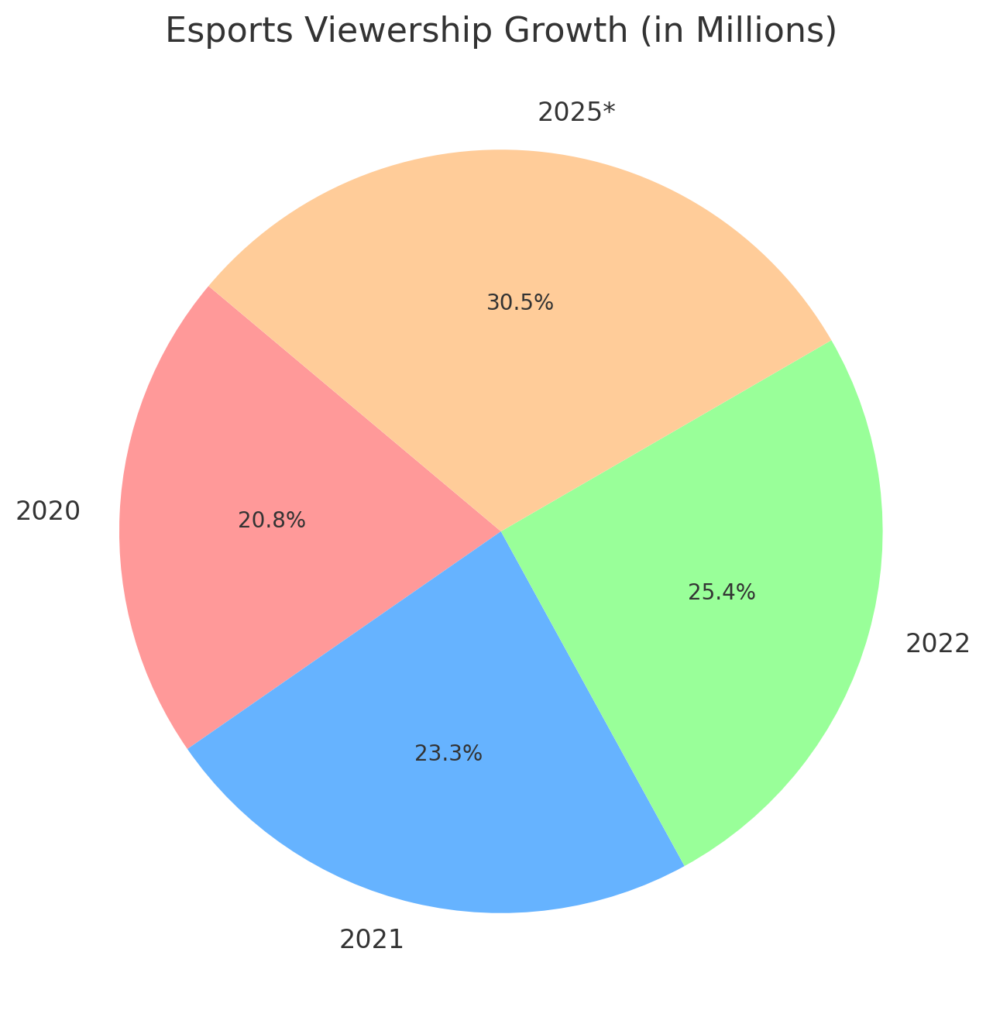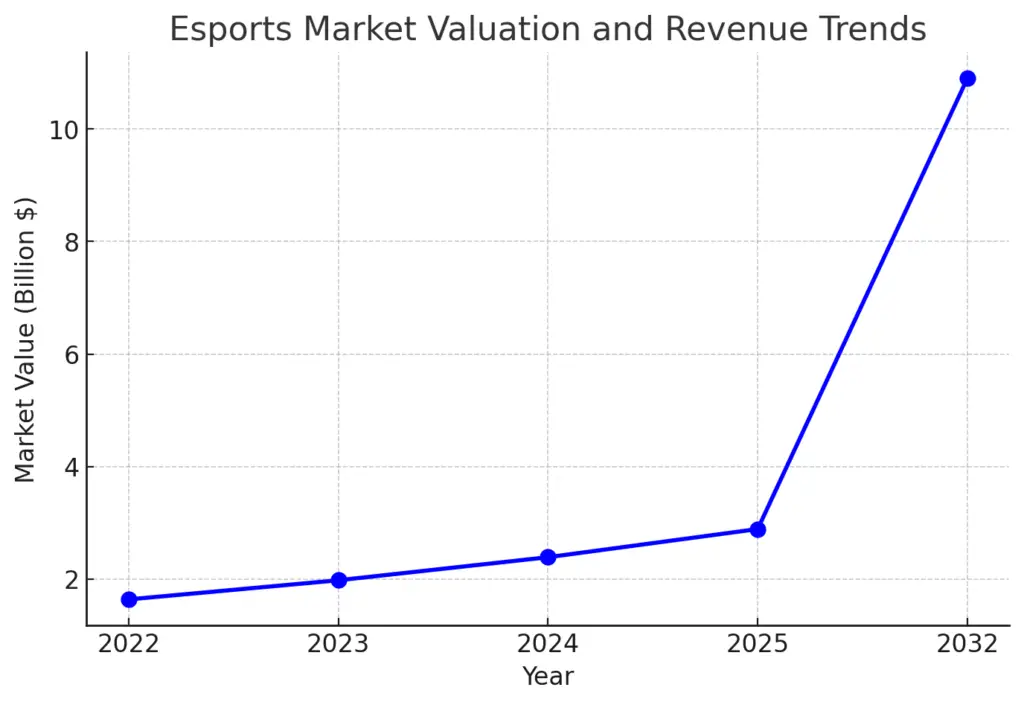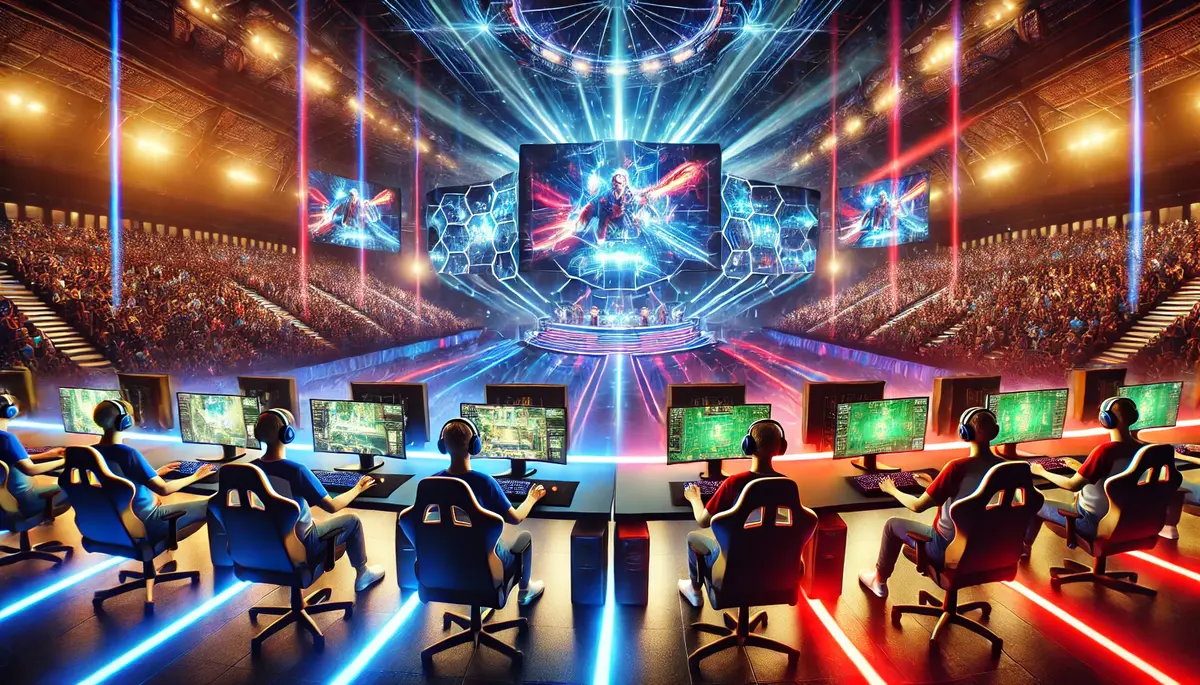eSports Viewership Statistics 2025: eSports has witnessed an explosive rise in popularity over the past decade, transforming from a niche pastime into a globally recognized phenomenon.
As we project into 2025, estimates suggest that the worldwide esports audience could surpass 640.8 million individuals.
This impressive figure is broken down into approximately 318.1 million dedicated fans who engage with esports content regularly, alongside an additional 322.7 million occasional viewers who tune in from time to time.
The Asia-Pacific region is leading this surge, accounting for more than 57% of the global esports audience—China and the Philippines alone contribute to around 40% of this fanbase.
These statistics highlight a significant cultural shift, demonstrating how esports has evolved into a mainstream sport, capturing the attention of the masses and attracting substantial revenue streams.
In this analysis, we will delve into the current esports statistics, exploring various facets such as audience figures, viewership trends, market values, and more.
2025 Esports Audience Predictions: Key Takeaways
- The global esports audience is anticipated to reach approximately 640.8 million by 2025.
- Dedicated fans will constitute around 318.1 million of this total, while occasional viewers are expected to reach 322.7 million.
- The United States currently boasts around 3,530 active esports players.
- The Asia-Pacific region dominates global esports viewership, representing over 57% of the total audience.
- Key markets such as China and the Philippines are critical to the growth of esports, representing about 40% of total fans.
- The global esports market is projected to be valued at approximately $2.89 billion.
- The esports market in the United States is estimated to be worth about $1.07 billion.
Growth of Esports Viewership
How Many People Watch Esports?

Projected growth in the esports audience is staggering. By 2025, the anticipated global audience is set to reach 640.8 million, up from 435.7 million in 2020. The increase in accessibility to gaming and enhanced streaming technologies have been instrumental in drawing more people into the esports ecosystem.
Here’s a breakdown of global esports viewership over recent years:
| Year | Esports Viewers |
|---|---|
| 2025* | 640.8 million |
| 2022 | 532.1 million |
| 2021 | 489.5 million |
| 2020 | 435.7 million |
As esports expands its audience, the growth trend seems poised to continue upward, fostering a more significant community of players, spectators, and enthusiasts.
Dedicated vs. Occasional Viewers
An intriguing distinction exists between those who regularly engage with esports content and those who watch sporadically. The popularity of various competitive games and the emergence of recognized players have fostered a vast array of influencers, helping build support among fan communities.
In 2025, it’s estimated that there will be approximately 318.1 million dedicated fans—individuals who follow esports closely—while the number of occasional viewers is projected to be around 322.7 million. Here’s how these numbers have evolved over the past few years:
| Year | Occasional Viewers | Dedicated Fans |
|---|---|---|
| 2025* | 322.7 million | 318.1 million |
| 2022 | 270.9 million | 261.2 million |
| 2021 | 249.5 million | 240 million |
| 2020 | 220.5 million | 215.2 million |
The rise in both categories reflects a vibrant culture around esports, showcasing its acceptance and growth internationally.
Regional Distribution of Esports Viewership
The Asia-Pacific region stands out as the powerhouse of esports viewership, with more than 57% of all global fans. Countries like Indonesia and China have significantly influenced this growth.
To illustrate the global distribution of esports viewers by region, consider the following:
| Region | Viewer Percentage |
|---|---|
| Asia-Pacific | 57% |
| Europe | 16% |
| North America | 12% |
| Rest of World | 15% |
In 2023, the U.S. had around 45 million esports viewers, underscoring the considerable interest in this digital sport. Meanwhile, Europe accounts for 16% of the overall audience, affirming its relevance in the global esports landscape.
Major Tournaments and Viewership Records
One of the most notable events in esports history is the League of Legends World Championship 2023, which achieved a staggering peak viewership of 6.4 million, marking the highest attendance to date. This statistic highlights the tremendous appeal of popular esports tournaments, drawing viewers worldwide. Here’s a brief look into some of the highest viewership records:
| Tournament | Peak Viewers |
|---|---|
| League of Legends World Championship 2023 | 6.4 million |
| Free Fire World Series 2021 | 5.41 million |
| League of Legends World Championship 2022 | 5.15 million |
| Mobile Legends M5 World Championship | 5.07 million |
| League of Legends World Championship 2021 | 4.02 million |
The Financial Landscape of Esports
The financial ecosystem surrounding esports is substantial and continues to grow dynamically. The global esports market is recognized to have reached a valuation of $2.89 billion in 2025, showing strong potential for expansion.
Esports Market Insights

In 2023, the esports market was valued at approximately $1.98 billion. With a forecasted annual growth rate (CAGR) of 20.9%, this sector is on course to considerably increase its economic impact and potential.
| Year | Market Value |
|---|---|
| 2022 | $1.64 billion |
| 2023 | $1.98 billion |
| 2024* | $2.39 billion |
| 2025* | $2.89 billion |
| 2026* | $3.50 billion |
| 2027* | $4.23 billion |
| 2028* | $5.11 billion |
| 2029* | $6.17 billion |
| 2030* | $7.46 billion |
| 2031* | $9.02 billion |
| 2032* | $10.9 billion |
Revenue Sources
In 2022 alone, sponsorships generated approximately $837.3 million, which constituted a significant portion of the revenue in the esports industry. In addition to sponsorships, other revenue streams include:
| Segment | Market Revenue |
|---|---|
| Sponsorships | $837.3 million |
| Media rights | $207.8 million |
| Publisher fees | $130.7 million |
| Merchandise and tickets | $107.9 million |
| Digital sources | $53.9 million |
| Streaming Revenue | $46.3 million |
These figures point to a healthy market that is recalibrating itself amid a shifting competitive landscape.
Players and Teams: The Backbone of Esports
The popularity of esports players and professional teams has rapidly grown, thanks to the increased visibility provided by tournaments, streaming, and social media platforms. Notably:
- In 2023, the United States had the most active esports players, with 3,530.
- China comes in second with 2,024 players, indicating their robust involvement in esports.
Here’s a snapshot of active esports players by country:
| Country | Number of Active Esports Players |
|---|---|
| United States | 3,530 |
| China | 2,024 |
| Brazil | 1,356 |
| Republic of Korea | 1,113 |
| France | 1,047 |
| Germany | 942 |
| Australia | 937 |
| Japan | 890 |
| Russian Federation | 886 |
| United Kingdom | 821 |
| Vietnam | 668 |
| Indonesia | 579 |
| India | 559 |
Source: Statista
Top Earners in Esports
Professional players have begun to earn significant amounts, making esports a viable career path. As of 2025, N0tail (Johan Sundstein) is the highest-earning male esports player, amassing around $7.18 million throughout his career. Scarlett (Sasha Hostyn), the highest-earning female player, has earned approximately $472,110.
Here are tables for both top male and female esports players by earnings:
Top Male Esports Players
| Player | Esports Earnings |
|---|---|
| N0tail (Johan Sundstein) | $7.18 million |
| JerAx (Jesse Vainikka) | $6.49 million |
| ana (Anathan Pham) | $6.02 million |
| Ceb (Sebastien Debs) | $5.95 million |
| Topson (Topias Taavitsainen) | $5.90 million |
Top Female Esports Players
| Player | Esports Earnings |
|---|---|
| Scarlett (Sasha Hostyn) | $472,110 |
| Liooon (Li Xiao Meng) | $241,510 |
| alexis (Alexis Guarrasi) | $131,290 |
Esports Organizations and Their Performance
Organizations have taken a central role in shaping the esports landscape. Team Liquid, a dominant force in competitive gaming, has achieved an impressive total of $53.42 million in prize money.
| Team | Country | Total Prize Money Won |
|---|---|---|
| Team Liquid | Europe | $53.42 million |
| OG | Europe | $38.7 million |
| Team Spirit | Russia | $31.79 million |
| Evil Geniuses | United States | $28.57 million |
| Natus Vincere | Ukraine | $23.36 million |
Streaming Trends in Esports
With the increasing demand for esports tournaments, the need for high-quality competitive games continues to rise. Popular genres include multiplayer games, first-person shooters, and battle royale titles.
DOTA 2 commands attention with a staggering prize pool, attracting major interest from competitors and spectators alike. In 2023, DOTA 2 featured a remarkable prize pool of approximately $29.56 million.
| Game | Collective Prize Pool |
|---|---|
| DOTA 2 | $29.56 million |
| Fortnite | $19.11 million |
| PUBG Mobile | $15.94 million |
| Counter-Strike: Global Offensive | $14.99 million |
| VALORANT | $8.5 million |
On the streaming front, Fortnite has emerged as a heavyweight, with over 5 million streamers showcasing their gameplay on platforms like Twitch, where the game has garnered more than 60 million watch hours.
General Esports Demographics
Several interesting demographic insights about esports around the world include:
- Approximately 70% of esports fans in the U.S. are male, while about 28% are female.
- The average age of esports viewers in the U.S. is around 29.
- The esports audience is projected to touch the remarkable figure of 1 billion by 2025.
- Significant prize pools are being awarded across various competitive games, highlighting the industry’s growth potential.
The Community and Cultural Impact of Esports
As esports continues to shape the entertainment landscape, its influence extends far beyond mere viewership and profit margins. The community that has formed around competitive gaming has evolved into a culture with its own norms, values, and social dynamics. Fans engage not only through watching matches but also by participating in discussions, streaming content, and forming relationships within the community.
Fan Engagement and Interaction
Esports significantly differs from traditional sports in how fans can interact with the content and the players themselves. Social media platforms like Twitter, Twitch, and YouTube provide avenues for real-time engagement. Gamers can watch live broadcasts, engage with streamers through chat, and even participate in online polls or contests, creating a vibrant ecosystem where fans feel directly connected to their favorite games and players.
Moreover, organizations are leveraging this engagement by producing content that resonates with fans. Behind-the-scenes videos, player interviews, and community-driven initiatives foster loyalty and strengthen the bond between players and their fans. By building relatable narratives around their teams and players, organizations create a loyal following that often extends beyond just watching competitive matches.
Diversity and Inclusion in Esports
One noteworthy aspect of the esports movement is its emphasis on diversity and inclusivity. While traditionally male-dominated, the esports community has started to embrace a wider range of participants. Initiatives aimed at promoting female gamers, LGBTQ+ visibility, and support for various ethnicities are becoming more commonplace. Events such as the Women in Esports Summit highlight the efforts being made to create a more inclusive environment while addressing issues such as gender disparity in the industry.
Additionally, many esports organizations are working to recruit diverse talent, recognizing that a wider range of perspectives can lead to innovative strategies and approaches in gameplay and management. This shift not only enriches the community but also attracts new audiences who see themselves represented.
Education and Career Opportunities in Esports
The growth of esports has also sparked an interest in educational opportunities within this field. Numerous institutions now offer specialized programs focusing on esports management, game design, and broadcasting. These programs equip students with the necessary skills to navigate the professional esports landscape, whether as players, managers, analysts, or content creators.
Institutions offering esports programs are increasingly partnering with professional organizations, providing students access to mentorship, internships, and real-world experience. As the industry matures, these educational pathways are critical for nurturing the next generation of talent, ensuring a sophisticated understanding of the complex dynamics that define esports.
Career Paths in Esports
The array of career opportunities in esports continues to expand. Beyond the obvious roles of players and coaches, numerous positions are emerging, including:
- Content Creators: Many players and enthusiasts turn to platforms like Twitch and YouTube to share their gaming experiences. These content creators build significant followings while contributing to the overall esports culture and community.
- Analysts and Commentators: Providing color commentary during matches requires a deep understanding of the games and the ability to convey that knowledge engagingly. Analysts also play critical roles in dissecting gameplay and developing strategies for teams.
- Event Organizers: The production of live tournaments involves extensive planning, logistics, marketing, and execution. Skilled event organizers are instrumental in creating memorable experiences for both players and fans.
- Marketers and Brand Managers: With brands increasingly looking to tap into the esports market, professionals in marketing and sponsorship are crucial for developing partnerships that benefit both organizations and brands.
- Game Developers: As esports thrives, the demand for high-quality games continues to grow. Developers and designers have the opportunity to create innovative competitive games that capture the interests of the gaming community.
The Future of Esports Technology
Technology continues to play a pivotal role in shaping the future of esports. Areas such as virtual reality (VR), augmented reality (AR), and artificial intelligence (AI) hold the potential to revolutionize how games are played and experienced. Advances in these technologies may lead to enhanced gameplay, more immersive experiences, and innovative streaming formats that attract even larger audiences.
Virtual Reality and Augmented Reality
VR and AR can create new ways for players to engage with games. Imagine a VR esports tournament where players participate in an immersive environment, feeling as though they are inside the game itself. Additionally, AR technology could facilitate real-time data overlays during live broadcasts, enhancing viewers’ understanding of strategies and gameplay mechanics.
Artificial Intelligence in Esports
AI is already making waves in esports through the development of adaptive training programs for players and analyzing vast amounts of gameplay data to provide insights. AI can help identify trends and optimize strategies, delivering a competitive edge on the esports battlefield.
Conclusion: A Bright Future for Esports
As we look forward to 2025, the esports community is on an exciting trajectory, with estimates suggesting that over 640.8 million people globally will be engaging with esports content. With 318.1 million dedicated fans and countless others tuning in occasionally, esports has undeniably cemented its place as a mainstream entertainment option.
The contributions of leading players, such as N0tail and Scarlett, alongside exceptional teams like Team Liquid, signify a maturing market filled with immense growth opportunities. The evolving landscape of esports presents a dynamic arena for players, influencers, and brands alike, with the future brimming with potential and excitement in this exhilarating industry.

